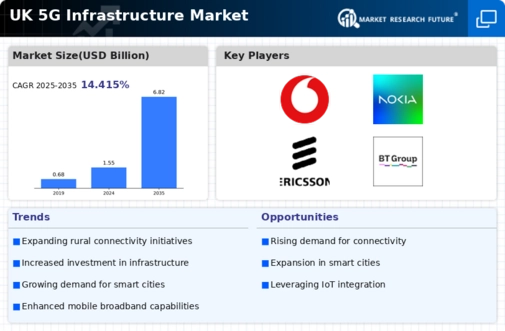Emergence of Smart Cities
The concept of smart cities is gaining traction in the UK, significantly influencing the 5g infrastructure market. As urban areas evolve to incorporate advanced technologies, the demand for high-speed, low-latency networks becomes critical. 5g infrastructure is essential for supporting various smart city applications, including traffic management, public safety, and energy efficiency. The UK government has identified smart city initiatives as a priority, with several cities already piloting 5g projects. This trend suggests that the integration of 5G technology into urban planning could lead to enhanced quality of life for residents and increased operational efficiency for city services, thereby driving growth in the 5g infrastructure market.
Growth of the Digital Economy
The digital economy in the UK is expanding rapidly, which is having a profound impact on the 5G Infrastructure Market. As more businesses transition to digital platforms, the need for advanced telecommunications infrastructure becomes increasingly apparent. The UK digital economy is projected to contribute £150 billion to the national GDP by 2025, highlighting the critical role of technology in economic growth. This expansion necessitates the deployment of 5g networks to support various applications, including e-commerce, remote work, and digital entertainment. Consequently, the growth of the digital economy is likely to drive significant investments in the 5g infrastructure market, as companies seek to enhance their connectivity and service offerings.
Government Initiatives and Funding
Government initiatives play a crucial role in shaping the 5g infrastructure market in the UK. The UK government has committed substantial funding to enhance digital connectivity, aiming to ensure that 5g technology reaches rural and underserved areas. Initiatives such as the £1 billion fund for 5g deployment are designed to stimulate investment and encourage private sector participation. These efforts are expected to create a more competitive landscape, fostering innovation and driving the adoption of 5g technologies. As a result, the 5g infrastructure market is likely to benefit from increased public and private collaboration, which could lead to a more comprehensive and widespread implementation of 5g networks across the country.
Increased Adoption of Cloud Services
The shift towards cloud-based services is significantly impacting the 5g infrastructure market in the UK. As businesses increasingly migrate their operations to the cloud, the demand for high-speed, reliable internet connections intensifies. 5g technology offers the necessary bandwidth and low latency required for seamless cloud computing experiences. Recent statistics indicate that cloud adoption in the UK is expected to reach 85% by 2025, further underscoring the importance of robust 5g infrastructure. This trend suggests that telecommunications providers must enhance their networks to accommodate the growing reliance on cloud services, thereby driving investment and innovation within the 5g infrastructure market.
Rising Demand for High-Speed Connectivity
The 5G Infrastructure Market is experiencing a notable surge in demand for high-speed connectivity across various sectors in the UK. As businesses and consumers increasingly rely on digital services, the need for faster and more reliable internet connections becomes paramount. This demand is driven by the proliferation of smart devices and the Internet of Things (IoT), which require robust network capabilities. According to recent data, the UK is projected to see a 30% increase in mobile data traffic by 2026, further emphasizing the necessity for advanced 5g infrastructure. This trend indicates that telecommunications companies must invest significantly in upgrading their networks to meet the evolving expectations of users, thereby propelling growth in the 5g infrastructure market.















Leave a Comment